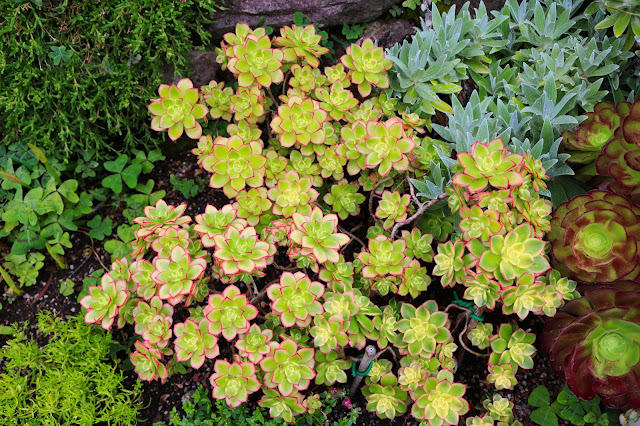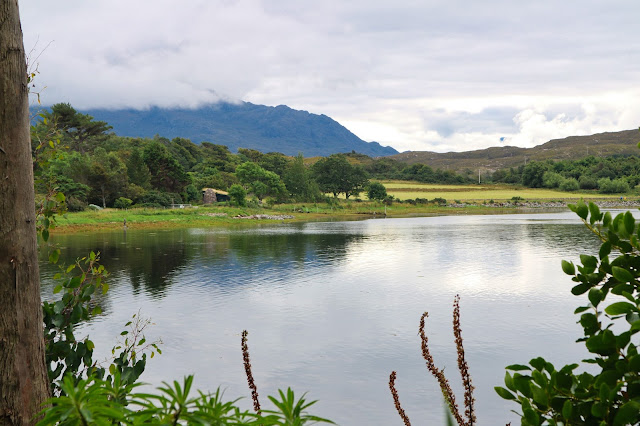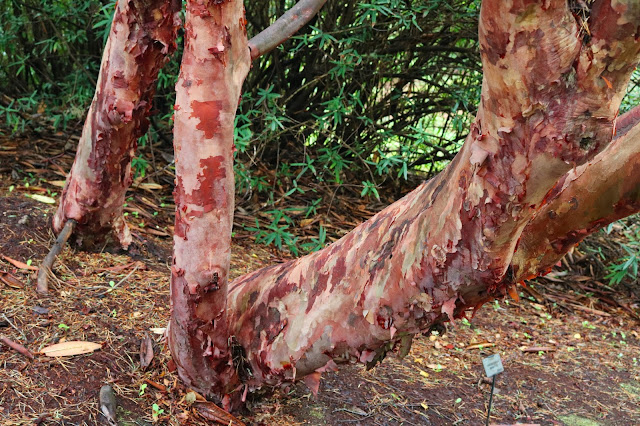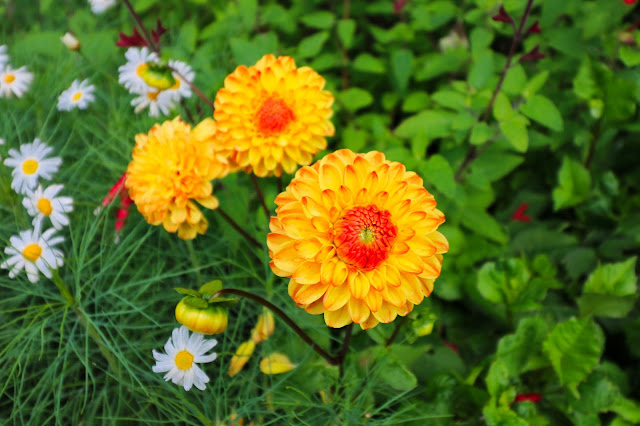Inverewe Gardens
We stopped at Inverewe Gardens on our way home at the recommendation of one of Steve's work mates. It's a property within The National Trust for Scotland, so admission is free to Trust members. We had been pondering joining since we first moved here and decided to just bite the bullet and sign up whilst we were at the gardens. We only have to visit about four more places to have the membership pay for itself. Since the Culloden Battlefield near us in Inverness is part of the Trust, and our membership also grants us access to England's National Trust locations, we figure our membership will end up saving us quite a bit within the year.
Inverewe Gardens was once the estate of Osgood Mackenzie. He built his mansion house on a rocky promontory overlooking Loch Ewe in the mid-19th century. He dreamed of having a walled garden of flowers and vegetables and set about excavating a raised beach and building retaining walls and terraces. By 1870, Osgood had created a productive garden inspired by his travels throughout Europe and his upbringing in nearby Gairloch.
Osgood's daughter, Mairi Sawyer, inherited the estate upon her father's death in 1922. She kept the garden project going. Her father's original mansion burned down in 1914. Mairi built a new house that was completed in 1937. Mairi first opened the gardens to paying visitors during World War II as a way to pay for the upkeep during the lean war years. Shortly thereafter, she approached the National Trust about a transfer of ownership to ensure the garden's future. The Trust took control of the property in 1952, and Mairi passed away a year later. The property was deemed inalienable in 1954, thus ensuring its preservation in perpetuity.
The rainy weather had moved off and we were treated to a lovely few hours at the gardens. Honestly, we could have happily spent more time there. And there are parts of the gardens we've not yet seen. But we wanted to be home by a specific time.
Here are some photos of what we saw:
We had watched an episode of Gardeners' World a couple of days before our trip, and he was talking about succulents. Since I can't exercise my green thumb with a garden outside, I think I may try some houseplants. Succulents like this aeonium seem like a good start.
This grassy plant was near the entrance walkway. What an unusual bloom!
Here's a zoomed-in image of it.
Each of the "leaves" is engraved with the name of donor. I'm not sure what they were raising money for, but the result was quite nice. It was like an oversized wind chime.
Not a bad view. The gardens overlook Lake Ewe, hence the name: Inverewe. "Inver," the Anglicized form of the Gaelic inbhir, is a common place-name meaning "confluence of water," or "river mouth." Inverness gets its name because it's situated at the mouth of the River Ness. At first I thought Inverewe was an inaccurate name. The gardens sit on Loch Ewe, where was the confluence? Then I realized that the Inverewe peninsula which constitutes the gardens actually divided Loch Ewe from Camas Glas. So the name works, after all.
Here's a map of Inverewe Gardens to better illustrate what I'm talking about:
Another succulent. Not all of the plants had ID signs. So we just had to admire them in ignorance. Honestly, this looks like it should be on Star Trek.
And another. This one is called Garnet, as you can see by the sign.
This is another succulent. I am fairly certain it's a type of echevarria.
Steve gave me a packet of sunflower seeds in my Christmas stocking because he knows I love them. I planted them once we moved and kept them in the kitchen windowsill. Only one plant was robust enough to grow well. I transplanted it into a bigger pot just as it was coming into bloom. Big mistake. I must have shocked it and it ended up looking more like a dandelion than an sunflower. So I enjoyed seeing these lovely plants.
This lovely gate led to the loch side. It commemorated the 50th anniversary of the gardens as a part of the National Trust.
I've always liked this type of hydrangea with the bi-colored flowers.
These plants are quite tall - over six feet. At first, we thought they were very big thistles.
But they were lacking the prickles. What were they?
Then Steve spotted a sign. They're artichokes! I didn't realize that artichokes grew so tall!
I don't know what this is, but it's pretty.
How's that for some rhubarb? Those stems are about four feet long!
Gorgeous pink lilies.
This is one industrious apple tree! It's only a sapling that's about five feet tall. The trunk is maybe about as big around as my thumb. But look at all the fruit!
This ugly fellow was slowly making his way across the pavement. We aren't sure why he had a flower stuck on his back end. I think this is a Spanish slug. It was about six or sevens inches long.
I think this flower looks like a crab claw. And I love the orange blossoms against the black stem.
This is the house that Mairi built. I liked the cottage-style planting of flowers. The house is open to the public during the summer months, but we opted to skip it in lieu of seeing as much of the garden grounds as possible since our time was limited.
Another plant with interesting foliage.
Another shot of the flowers growing in an arc in front of the house.
The view of the loch from the house. I can see why Osgood sited the house here.
The garden has a "Big Trees" section that includes giant redwoods, as well as red cedars and other tall trees that I couldn't identify.
This tree clearly had a huge growth spirt before it was chopped down.
This is a rhododendron barbatum. It's red/pink bark was like paper.
Another barbatum
This is the High Overlook.
We walked down to the rocks. There were several people lounging on the rocks to the right, so I just focused to the left to keep them out of the frame. Which is a pity, as the view was nice the other way.
We walked over to the jetty that extends into Camas Glas, where I spotted this sign. The image has been damaged, so it now looks like you're supposed to use a jet pack and launch off the jetty.
And here's the jetty.
Camas Glas to the right of us.
The view to the left, where Camas Glas meets Loch Ewe. And the rocks with people on them. But they're different people.
We saw a lot of these plants in the forest and assumed they were hogs weed, a very toxic plant. But when we saw them growing right next to the path, we reconsidered. There's no way the garden staff would allow something as toxic as hogsweed within easy reach of guests. Hogsweed sap causes painful blisters to erupt on your skin pretty much on contact. The plant had no ID sign, so I did a bit of online sleuthery (I know, that's not a word but it sounds good) and discovered it's a gunnera manicata; also known as Chilean or Brazilian rhubarb. It's a very impressive plant. I asked Steve to pose with it just to give an idea of how huge it is.
A taste of the woodland walk.
Yet another scenic viewpoint.
These design under the petal of these flowers remind me of peacock feathers.
A view from above the Victorian walled garden first created by Osgood Mackenzie.
Another shot of the garden. We went through this area toward the beginning of our visit, but we walked along the bottom. You can see the pink lilies at around four o'clock. I posted a photo of them earlier in the blog.
So pretty
The colors were gorgeous. The darker edge of the petals create the dark center.
A very unusual plant
And finally, a shot of one of the many different types of eucalyptus trees that punctuated the gardens.
The gardens are open year-round, so I hope to visit once or twice more during the different seasons.
Inverewe Gardens was once the estate of Osgood Mackenzie. He built his mansion house on a rocky promontory overlooking Loch Ewe in the mid-19th century. He dreamed of having a walled garden of flowers and vegetables and set about excavating a raised beach and building retaining walls and terraces. By 1870, Osgood had created a productive garden inspired by his travels throughout Europe and his upbringing in nearby Gairloch.
Osgood's daughter, Mairi Sawyer, inherited the estate upon her father's death in 1922. She kept the garden project going. Her father's original mansion burned down in 1914. Mairi built a new house that was completed in 1937. Mairi first opened the gardens to paying visitors during World War II as a way to pay for the upkeep during the lean war years. Shortly thereafter, she approached the National Trust about a transfer of ownership to ensure the garden's future. The Trust took control of the property in 1952, and Mairi passed away a year later. The property was deemed inalienable in 1954, thus ensuring its preservation in perpetuity.
The rainy weather had moved off and we were treated to a lovely few hours at the gardens. Honestly, we could have happily spent more time there. And there are parts of the gardens we've not yet seen. But we wanted to be home by a specific time.
Here are some photos of what we saw:
We had watched an episode of Gardeners' World a couple of days before our trip, and he was talking about succulents. Since I can't exercise my green thumb with a garden outside, I think I may try some houseplants. Succulents like this aeonium seem like a good start.
This grassy plant was near the entrance walkway. What an unusual bloom!
Here's a zoomed-in image of it.
Each of the "leaves" is engraved with the name of donor. I'm not sure what they were raising money for, but the result was quite nice. It was like an oversized wind chime.
Not a bad view. The gardens overlook Lake Ewe, hence the name: Inverewe. "Inver," the Anglicized form of the Gaelic inbhir, is a common place-name meaning "confluence of water," or "river mouth." Inverness gets its name because it's situated at the mouth of the River Ness. At first I thought Inverewe was an inaccurate name. The gardens sit on Loch Ewe, where was the confluence? Then I realized that the Inverewe peninsula which constitutes the gardens actually divided Loch Ewe from Camas Glas. So the name works, after all.
Here's a map of Inverewe Gardens to better illustrate what I'm talking about:
Another succulent. Not all of the plants had ID signs. So we just had to admire them in ignorance. Honestly, this looks like it should be on Star Trek.
Another type of aeonium
This is another succulent. I am fairly certain it's a type of echevarria.
Steve gave me a packet of sunflower seeds in my Christmas stocking because he knows I love them. I planted them once we moved and kept them in the kitchen windowsill. Only one plant was robust enough to grow well. I transplanted it into a bigger pot just as it was coming into bloom. Big mistake. I must have shocked it and it ended up looking more like a dandelion than an sunflower. So I enjoyed seeing these lovely plants.
This lovely gate led to the loch side. It commemorated the 50th anniversary of the gardens as a part of the National Trust.
I've always liked this type of hydrangea with the bi-colored flowers.
These plants are quite tall - over six feet. At first, we thought they were very big thistles.
But they were lacking the prickles. What were they?
Then Steve spotted a sign. They're artichokes! I didn't realize that artichokes grew so tall!
I don't know what this is, but it's pretty.
How's that for some rhubarb? Those stems are about four feet long!
Gorgeous pink lilies.
This is one industrious apple tree! It's only a sapling that's about five feet tall. The trunk is maybe about as big around as my thumb. But look at all the fruit!
This ugly fellow was slowly making his way across the pavement. We aren't sure why he had a flower stuck on his back end. I think this is a Spanish slug. It was about six or sevens inches long.
I think this flower looks like a crab claw. And I love the orange blossoms against the black stem.
This is the house that Mairi built. I liked the cottage-style planting of flowers. The house is open to the public during the summer months, but we opted to skip it in lieu of seeing as much of the garden grounds as possible since our time was limited.
Another plant with interesting foliage.
Another shot of the flowers growing in an arc in front of the house.
The view of the loch from the house. I can see why Osgood sited the house here.
The garden has a "Big Trees" section that includes giant redwoods, as well as red cedars and other tall trees that I couldn't identify.
This tree clearly had a huge growth spirt before it was chopped down.
This is a rhododendron barbatum. It's red/pink bark was like paper.
Another barbatum
This is the High Overlook.
We walked down to the rocks. There were several people lounging on the rocks to the right, so I just focused to the left to keep them out of the frame. Which is a pity, as the view was nice the other way.
We walked over to the jetty that extends into Camas Glas, where I spotted this sign. The image has been damaged, so it now looks like you're supposed to use a jet pack and launch off the jetty.
And here's the jetty.
Camas Glas to the right of us.
The view to the left, where Camas Glas meets Loch Ewe. And the rocks with people on them. But they're different people.
We saw a lot of these plants in the forest and assumed they were hogs weed, a very toxic plant. But when we saw them growing right next to the path, we reconsidered. There's no way the garden staff would allow something as toxic as hogsweed within easy reach of guests. Hogsweed sap causes painful blisters to erupt on your skin pretty much on contact. The plant had no ID sign, so I did a bit of online sleuthery (I know, that's not a word but it sounds good) and discovered it's a gunnera manicata; also known as Chilean or Brazilian rhubarb. It's a very impressive plant. I asked Steve to pose with it just to give an idea of how huge it is.
A taste of the woodland walk.
Yet another scenic viewpoint.
These design under the petal of these flowers remind me of peacock feathers.
A view from above the Victorian walled garden first created by Osgood Mackenzie.
Another shot of the garden. We went through this area toward the beginning of our visit, but we walked along the bottom. You can see the pink lilies at around four o'clock. I posted a photo of them earlier in the blog.
So pretty
The colors were gorgeous. The darker edge of the petals create the dark center.
A very unusual plant
And finally, a shot of one of the many different types of eucalyptus trees that punctuated the gardens.
The gardens are open year-round, so I hope to visit once or twice more during the different seasons.



























































Comments
Post a Comment